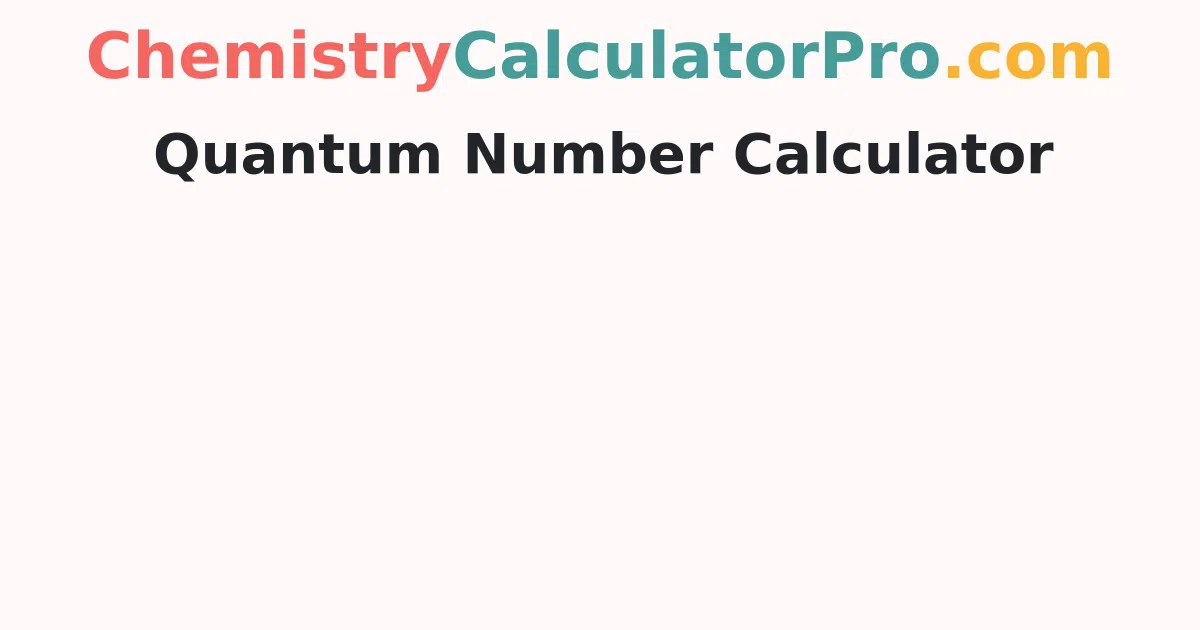Quantum Number Calculator
Are you fed up with calculating the quantum numbers manually? Here is the best & free online tool that takes h, k, l inputs and generates output in split seconds. So, use this handy quantum number online calculator and select the type of quantum number and give the values in the required fields for quick results.
Quantum Number Definition
Quantum numbers are the energy levels of an electron in an atom that are represented by integers. Quantum numbers prove the relative distance of the electron from the nucleus, types of orbital, and direction of spin in an atom. Also, it is used to explain the trajectory and the movement of an electron in an atom.
There are four different quantum numbers that are used to describe all the attributes of a given electron in an atom. They are:
- Principal quantum number
- Orbital angular momentum quantum number (or Azimuthal quantum number)
- Magnetic quantum number
- The electron spin quantum number
These four quantum numbers are discussed clearly in the below following sections. So, look at the deeper explanation about them and learn the concept of quantum numbers as well as use the online quantum number calculator chemistry for faster results.
Principal Quantum Number
The symbol to denote the principal quantum number is 'n'. It describes the electron shell or energy level of an atom. The principal quantum number demonstrates the relative distance of electrons having distinct n values in a multi-electron atom from the nucleus. For instance: if n=1, Orbit or shell is K, if n=2, Orbit or shell is L, and so on.
Remember that the principal quantum number, n, cannot be equal to 0 or have a negative value as it is not feasible for an atom to have a negative value or n0 value for a principal shell.
Angular Momentum Quantum Number
Describes the shape of the subshell and its orbitals are called angular momentum quantum numbers. It is denoted with the symbol 'l' where l = 0,1,2,3,... contains s, p, d, and f orbitals respectively.
For instance, if the n=2 shell has subshells of l = 0, 1, that means the n = 2 shell includes s, p subshells. This tells that each shell has up to n-1 types of subshells or orbitals.
Magnetic Quantum Number
This type of quantum number will directly define the total number of orbitals consisting in a subshell and the orientation of these orbitals. The symbol that denotes the magnetic quantum number is 'ml'. The feasible values for ml of any type of orbital are specified by an integer value from -l to l.
m = 2l + 1 (values of l=+1 to -1 including zero)
Here the number of m value finds the number of orbitals of a specific type.
Spin Quantum Number
Finally, the last quantum number is the electron spin quantum number which has two types of velocity. There are orbital velocity and axial velocity. Also, it has two possible values +1/2 and -1/2. These two electrons revolve clockwise and anticlockwise over their own axis and give a magnetic field. The notation of spin quantum number is 's'.
The positive value of ms suggests an upward spin on the electron also known as ‘spin up’ and is indicated by the symbol ↑. If ms has a negative value, the electron in question is said to have a downward spin, or a ‘spin down’, which is denoted by the symbol ↓.
If n portrays the shell, then both n and l mean a subshell. n, l, and ml describe an orbital and all combined numbers (n, l, ml, ms) describe an electron.
Quantum Number Chart
The following table represents the chart of the allowed quantum numbers that help you refer to the values so quickly and easily. Look at the quantum numbers chart below:
| n | l | ml | Number of orbitals |
Orbital Name |
Number of electrons |
| 1 | 0 | 0 | 1 | 1s | 2 |
| 2 | 0 | 0 | 1 | 2s | 2 |
| 1 | -1, 0, +1 | 3 | 2p | 6 | |
| 3 | 0 | 0 | 1 | 3s | 2 |
| 1 | -1, 0, +1 | 3 | 3p | 6 | |
| 2 | -2, -1, 0, +1, +2 | 5 | 3d | 10 | |
| 4 | 0 | 0 | 1 | 4s | 2 |
| 1 | -1, 0, +1 | 3 | 4p | 6 | |
| 2 | -2, -1, 0, +1, +2 | 5 | 4d | 10 | |
| 3 | -3, -2, -1, 0, +1, +2, +3 | 7 | 4f | 14 |
For more such chemistry concepts and their online calculators do visit our reliable and trusted website chemistrycalculatorpro.com and make your chemistry problems so easy and quick.
FAQs on Free Quantum Number Calculator Online with Steps
1. How do you calculate quantum numbers?
Firstly, take the element that you want to calculate the quantum number from the periodic table. Next, determine the principal number that indicates the element's energy. And later on, find the quantum numbers.
2. What are the 4 quantum numbers that explain each?
Quantum numbers are four and thet are principal(n), angular momentum(l), magentic moment(ml), and spin(ms).
3. What are the possible values of four quantum numbers?
| Number | Symbol | Possible Value |
|---|---|---|
| Principal Quantum Number | n | 1,2,3,4,… |
| Azimuthal Quantum Number | l | 0,1,2,3,….(n-1) |
| Magnetic Quantum Number | m1 | -l,….,-1,0,1,…l |
| Spin Quantum Number | ms | +1/2,-1/2 |
